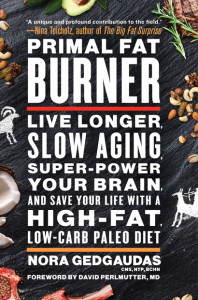Q: What do I feed my children (2, 5, 8)? Carbohydrates do not agree with them at all and cause many digestive issues so I am comfortable putting them on a low-carb diet, but it seems that meat always becomes the focus. How can I make fat the focus?? I can’t just put a glob of fat on their plates. This evening, we had chicken, Swiss chard and a salad. The 2 year old ONLY ate chicken – no veggies (even though I buttered the Swiss chard & had a flax-oil based dressing on the salad). The five year old only ate chicken and Swiss chard. Especially for the two year old, he needs fat! But the only way I can seem to get it into him is with a carby-type snack (and the carbs really do not agree with him). I saw your recipe for nut balls – I will be making those as our snacks. But just a little lost on how to set up our actual meals… I guess it’s just a matter of sticking with the non-starchy vegetables and serving nothing else until he starts trying them (??)…
A: Dietary fat is richly present within animal source foods (meat, poultry, seafood and fish). Choosing fattier cuts of meat is a great way to increase the fats. Use less lean ground beef, rib-eyes instead of tenderloins, lamb, pork, etc. Leaving the skin on poultry and using dark, instead of light meat, for instance, can also be a way of significantly increasing fat content (leg and thigh meat is also less expensive than breast meat…and more nutritious!). You can also sauté onions and mushrooms in butter or olive oil and pour that over meat or fish as a bonus. Choosing oilier fish such as salmon (and cooking in butter or coconut oil) is another way. Add healthy, rich sauces. There is no need to overly restrict protein with children and teens, as they are growing and their cells reproducing rapidly as part of their normal development. Restricting the carbohydrates (sugar and starch) still makes good sense. If they like the veggies, great. If not, don’t worry about it too much. You could try my “Cauliflower Mashers” recipe as another approach to veggies kids really love (better than mashed potatoes!). Nutrient dense, complete protein and natural fat are the most important thing in a developing child. You could possibly try green drinks (NanoGreens are delicious) if you want them to have the extra antioxidants and phytonutrients available in veggies. Additional fat can be from melted butter, coconut milk, olive oil, supplemental omega 3’s (preferably from fish oil and not so much from flax oil)…etc. Avocados (very rich in monounsaturated fats) are a great addition to the meal, which kids usually love. –Or make guacamole. Remember—it’s about making sure that you’re eating a variety of natural fats and including sufficient essential fatty acids. Eat just enough natural fat to satisfy your appetite—but don’t feel like you have to wash down a meal with a mug of liquid lard. 😉
~ Nora




I have a variety of ways to get fat into my 11 yo son, as he tends to cut off any fat visible from meat (though what he calls “fat” isn’t usually fat – it’s melted connective tissue, tendon, that squishy stuff between muscles, or just plain gristle). So I liberally lace his other foods with natural fats (coconut oil, home rendered lard, egg yolks, grassfed butter & ghee, raw whole milk cheese, etc.): coconut milk smoothies, heavy cream (40% butterfat) in hot cocoa (homemade, not a commercial mix), “creamed” veggies and cream soups, homemade low sugar ice cream and baked custard, egg nog (raw egg yolks, cream, and milk & a hint of maple syrup), sour cream, whole milk yogurt, bacon, sausage, 12 hour roasted pulled pork shoulder with some of the drippings stirred back in, and so on.
With his high fat intake (no gluten/wheat, low-to-moderate carb intake) he can hold off on between meal snacks. He’s lean, active, and has very strong bones and apparently, decay-resistant teeth. When he was eating wheat and other high starch foods, he was constantly hungry and asking for between-meal snacks.
The smoothies are a great way to get fats into them – gently melted coconut oil and ghee in a coconut milk or coconut yogurt base, egg yolk, some greens, bee pollen, a few berries if there’s the feeling that ‘it’s just not a smoothie unless it’s fruit’. A little stevia. I even throw in a some dulse and chia seeds, but I’m that way…. comes out like a slightly salty pudding.
Trial and error is, of course, the bottom line, but I think that can be less than helpful when you’re starting from scratch and aren’t interested in conducting long-term, detailed experiments in the health of your kids, so I thought it might help to give a rough sample outline of what a diet consisting of about 3 oz. of protein with some non-starchy vegetables and the rest of the calories coming from fat might look like.
To do this, I first did a search for a caloric calculator for kids and found pediatrics.about.com. According to its calculator, the average 2-3 year old, moderately active male kid needs 1k – 1400 calories per day. Then I went to nutrientdata.com, calculated how many calories were in 3 oz. of ground, grass-fed beef, how much butter would bring the total calories up to a little under 1k, and how many collards would be needed to cap the whole off to the desired 1,000 calories.
I found that with 3 oz. of beef, one would need 3.5 oz. of collard greens and 1 stick of butter per day to provide 1,000 calories.
That should give an idea of the kind of process one might use to make menus of the right coloric ratios (at least, according to my interpretation of PB-PM), namely: use an online calorie calculator to find out your target range of calories, and then use some online database like nutrientdata.com to calculate exactly how you’ll reach the target number of calories.
Of course, getting too detailed with this isn’t very plausable, but doing it once or twice should give you a decent “feel” for how much of things to use for getting the right balance of foods to achieve optimum health. Shakes (with all their milk, eggs, and yoghurt) are a great breakfast idea, and puddings are generally well received at any time of day.
As for making things appetizing, I like having salads for lunch because they elegantly handle boiled eggs, cheese, meat, and a hearty dressing all of which provide lots of good fats with virtually no carbs. I’m also greatly in favor of rich stews and soups made with fatty meat (like lamb) and non-starchy vegetables sauted in butter or tallow (I make liberal use of turnips and leeks). Simplest of all, of course, is just just cooked vegetables: braise brussel sprouts in cream (I’ve heard this is a French thing), steam cauliflower and pop some butter on top, saute green beans in coconut oil, etc. Getting frozen vegetables for this makes it ever so convenient to whisk them from the freezer to the frying pan or steamer without chopping, skinning, or any other kind of fussing.
I hope this will help give you an idea both on the basic quantities involved and how these quantities can be packaged up to be nice. Ultimately, however, we musn’t kid ourselves; a diet like this IS a radical change from the standard and, therefore, it DOES take a great deal of care and discipline not just on the part of the loving cook, but also on the part of the recipients. I think that one simply cannot reasonably expect this diet to be just as sweet and fast as the normal, chocolate-frosted-sugar-bombs and wonderbread wasteland found in the typical, diebetes, heart-failure, and cancer-ridden household.
So if you actually got to the end of this (whomsoever you may be) thank you for your attention, and fare thee well!
Keep in mind that 3 oz of ground beef is the equivalent of about 23 or 24 grams of protein–about half the adequate daily need of the “average” adult person exercising modified caloric restriction. Also remember that one should not overly restrict protein (or fat) consumption in children. They are growing, so it is appropriate that their reproductive metabolic pathways be up-regulated. It’s those of us that are done growing or not in pregnancy mode that might want to think about exercising modified caloric restriction (CRON–caloric restriction with optimal nutrition/nutrient density).